Ultimate Trolling Solutions
Story and photos by Troy A Buzalsky
When sizing up a fishing opportunity one must look at the facts, possibilities, probabilities, and resources available. A well-versed captain carefully reads and reacts to these situations, ultimately developing a game plan for action. Equally important to the game plan is the ability to adjust the tactics and strategies as additional information and influences present themselves.
Today’s angler has many tools in the toolbox that can help get the boat and the anglers on fish. After all, isn’t that the name of the game? When searching for fish, the captain hopefully has already researched the fishery, knowing if and when the fish are in the area. The captain has hopefully already looked at weather reports, tides if applicable, and even recent fishing reports. Even with first-rate intel the captain oftentimes needs to search the waters to find willing underwater participants.
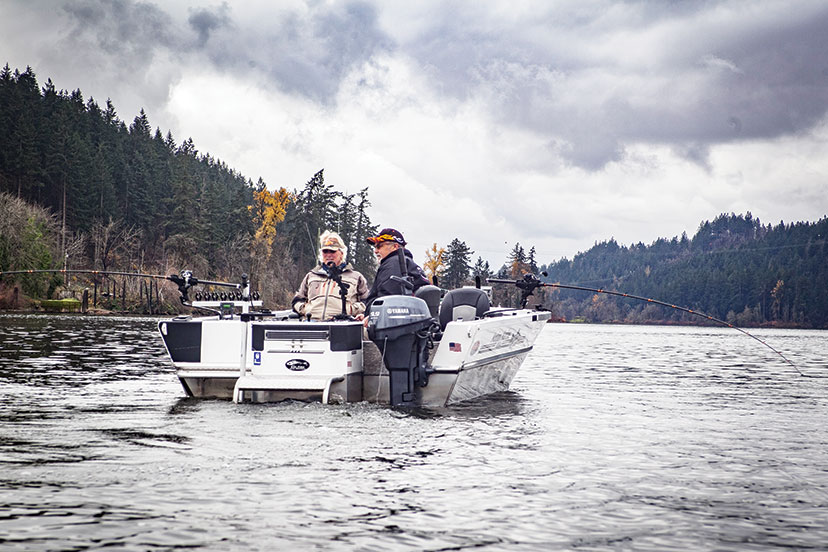
Pete Tracy and Dave Frances troll for fall coho using the Garmin Reactor 40 Kicker coupled with the Garmin ECHOMAP UHD and Panoptix LiveScope. You can hear their vintage ‘70s playlist in the background thanks to the Fusion MS BB100 Music System.
The boating angler has a leg up on the bank angler when it comes to search techniques in big water. Today’s boating angler has the highest quality sonar and cartography available, including technologies like CHIRP, side-scanning, down-scanning, and now the live-scanning sonars. These electronics also measure water temperature, speed over ground, and can even help the inquisitive captain determine bottom composition. Even geared with all these technologies, searching for fish is still a fact of life, and trolling allows the angler to cover water while both fishing and searching.
Like all electronics, as soon as you purchase the newest state-of-the-art gadgetry, you are already behind the curve, as newer technologies evolve and some of these are true game changers. I recently spent a day in a large estuary fishing with a boat full of eager, yet rookie anglers. They couldn’t tie knots, couldn’t bait hooks, couldn’t net fish, and certainly could not be trusted with the tiller handle. After an exhausting day playing bumper boats with the crowd and being tossed around the sloppy seas I came home and told my wife, “I can’t do this anymore. I either need an autopilot or a deck-hand.” To my surprise, she agreed.
My boat is my pride and joy. There are many newer, many bigger, and even more-powerful boats, but my little 18-foot open jet sled with a 175-horsepower SportJet meets most of my fishing and whitewater needs, and I take pride in how she’s equipped and how she performs. It was only about 10 years ago when I upgraded her electronics to include a Lowrance HDS Gen 2 fishfinder/chartplotter complete with Structure Scan and a Sonic Hub sound system. The unit served me well. It has all my saved waypoints, and there was no tangible reason to upgrade…or so I thought.
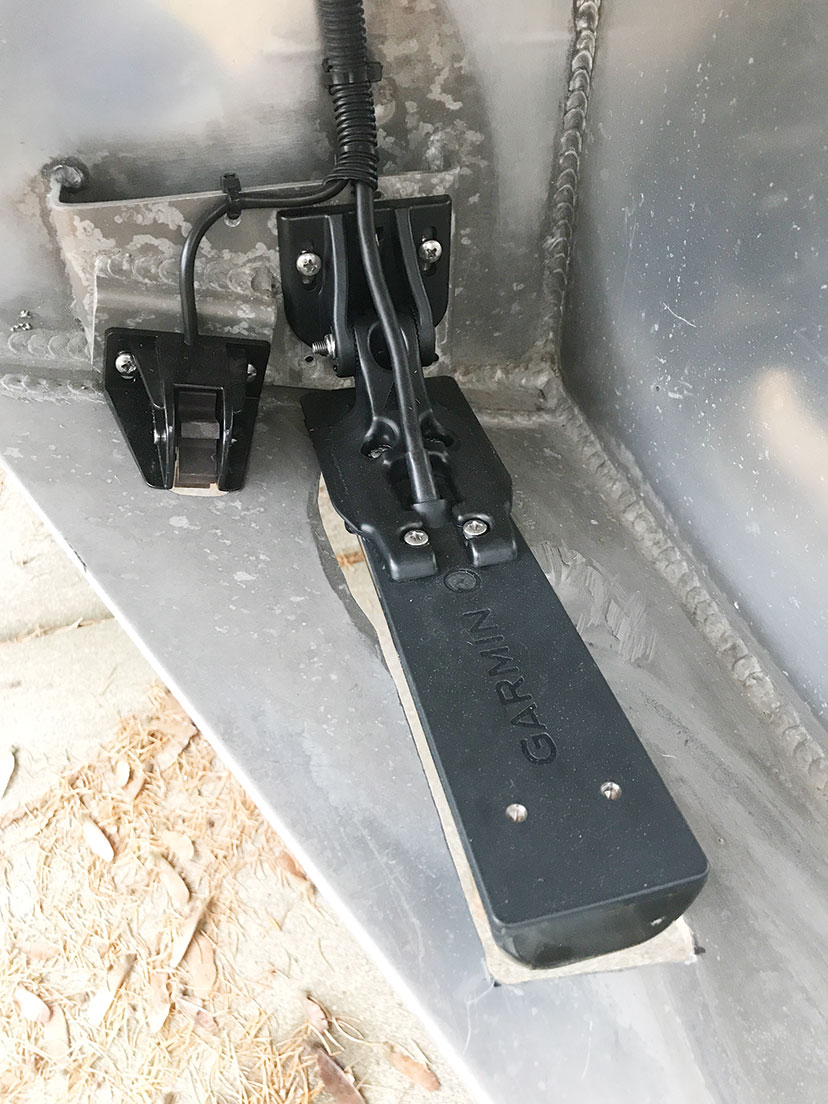
The author’s installation included the three-frequency Garmin GT56UHD-TM that provides CHIRP High-Wide and UHD ClearVü/SideVü sonar. The speed wheel was added to better compare over-water versus over-ground speed while trolling.
Having been an original Nautamatic TR-1 Gold autopilot customer I was quite familiar with its hands-free wireless operations, and eager to explore the possibilities of the successor: the Garmin Reactor Kicker 40 Autopilot. At the same time, I also wanted to evaluate the option of a bow-mounted, Spot-Lock-capable, battery-operated trolling motor. Lowrance, Garmin, Rhodan, MotorGuide and Minn Kota all have products in this category.
Hoping to not change out my electronics (more on this later), and not wanting to add extra batteries to run the bow-mounted trolling motor, I opted to punt the bow-mounted trolling-motor option to a possible future upgrade and stay the course on a traditional trolling motor autopilot. For more information on the benefits of a bow-mounted trolling motor, review Fish Alaska magazine’s May 2016 feature article titled “The Game Changer.”
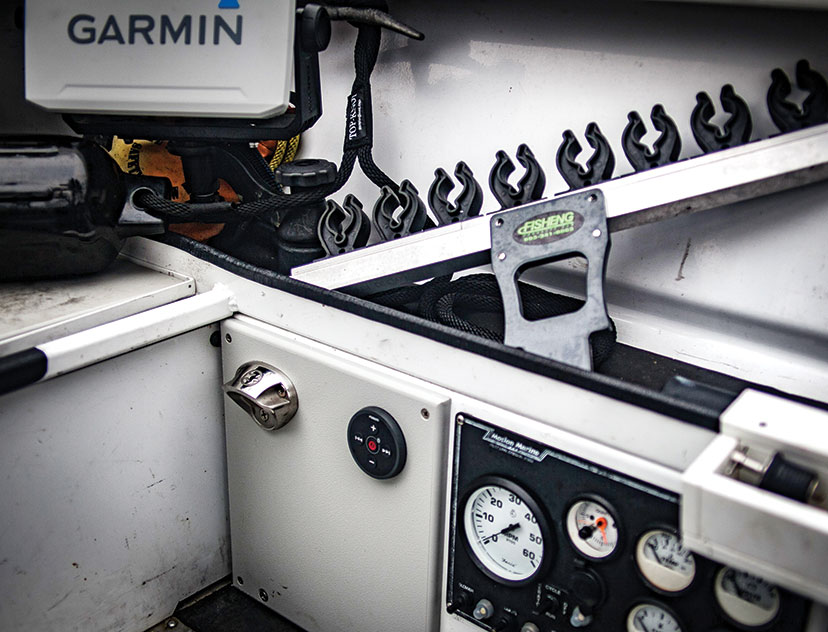
Replacing the Lowrance Sonic Hub was accomplished with a Garmin-brand Fusion MS BB100 remote black box with a wired remote. The system is Bluetooth, and pairs easily to your smartphone.
The Garmin Reactor 40 Kicker Autopilot is specially designed for boats with small outboard kicker motors, hence the kicker nomenclature. The Reactor 40 Kicker is engineered to help you maintain speed, heading hold, and the programmed route even against wind, waves, and heavy current. The unit features a wireless, waterproof remote with touch-of-a-button throttle control, and a convenient “point-and-go” feature. The Reactor 40 Kicker is also compatible with Garmin chartplotters or can be used with other electronics by adding the Garmin GHC 20 Display.
So far, so good on the research; the Reactor 40 Kicker would be the autopilot of choice. My friend and electronics installer at Portland Marine & Electronics, Alan Best, then suggested it was time for an upgraded chartplotter/sonar, explaining I could install the GHC 20 and use my current electronics, but suggested it was time for an upgrade. Gulp. An upgrade? My electronics are fine! Alan explained that just like my old plasma-screen TV and first-generation smartphone, much has changed for the better in the electronics world, and upgrading to a Garmin chartplotter/sonar would be a wise decision.
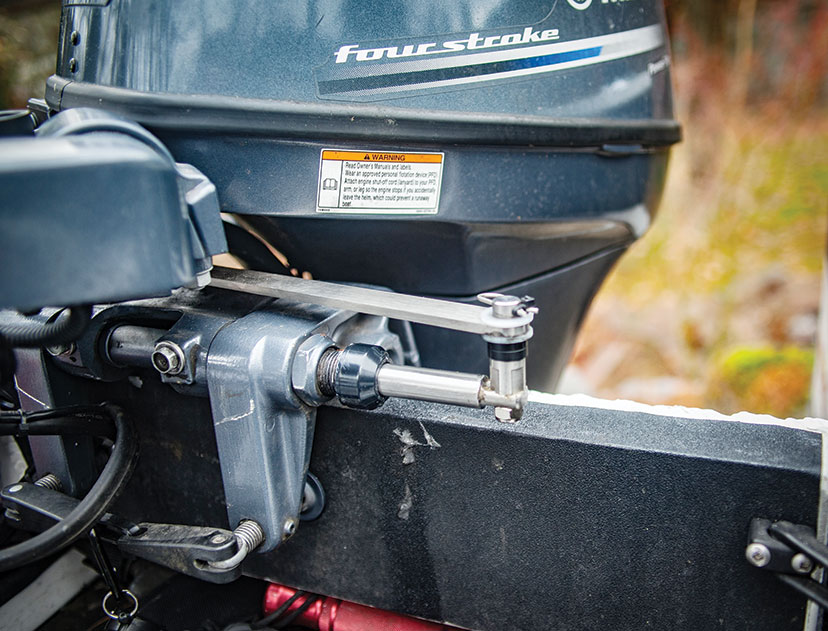
The Garmin Reactor 40 Kicker linkage arm pivots during operation and must have proper clearance.
Research, and Alan’s influence, led me to the Garmin ECHOMAP UHD Series with CHIRP traditional ultra-high-definition (UHD), SideVü and ClearVü sonar. Upgrading to this unit would also provide touch-screen operation, better high-contrast definition, BlueChart coastal charts, Quickdraw technology, and the ability to add Panoptix LiveScope…a technology I have been yearning to try out. “And look honey, I applied the savings from the GHC 20 to make the new electronics more affordable,” I explained to my wife.
So far, so good, but what about my already-installed Lowrance Sonic Hub and speakers? Had I not already had the speakers installed I may have chosen a different direction, but in keeping with the program, I elected to install the Garmin Fusion MS BB100 Black Box wired remote Bluetooth music system. The MS BB100 is designed to save space by being remotely installed, which is critical in an open fishing boat like mine where storage and hiding nook-and-crannies are at a premium.
Finally, it was time to dig into the secret fishing fund and order up the Garmin Panoptix LiveScope System. The system came complete with the GLS 10 sonar black box and LVS32 transducer. Next, I needed to come up with a clever way to mount the transducer, and my priority was to have the transducer quickly and easily removable. Portland Marine suggested looking at the options available at Fishing Specialties, a Colorado-based company that specializes in transducer-mounting systems, including the Panoptix LiveScope Transducer. To get full utilization from Panoptix LiveScope, the transducer needs to be 360 degrees rotational to fully utilize the forward and down-view features, and have the ability to rotate the transducer 90 degrees for the perspective view. Mike Hagen, owner and operator of Fishing Specialties is a true expert in the field, and it only took a quick phone call and I had my mounting system figured.
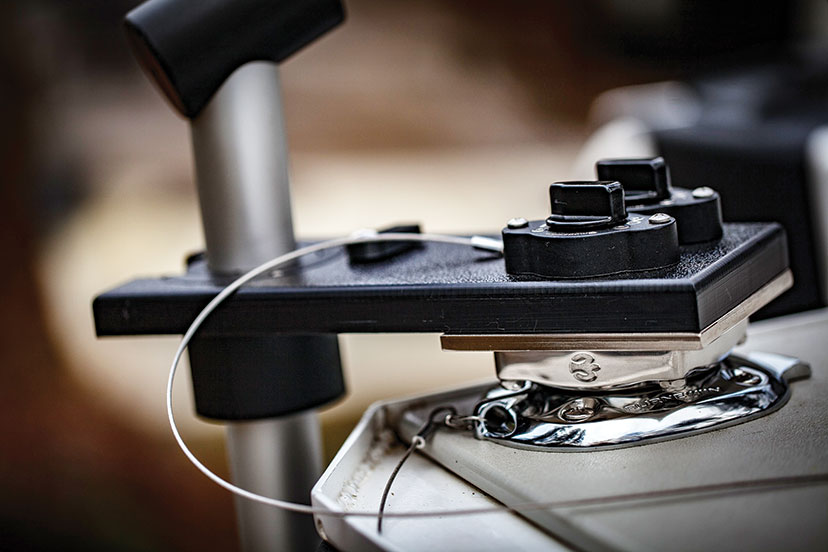
A close-up of the quality of the Burnewiin Mount and Base when coupled with a Fishing Specialties Magnetic Baseplate Assembly.
Fishing Specialties suggested their magnetic-baseplate system with a 1½-inch-diameter, one-piece, 48-inch active target downrod system. The assembly features a tiller-style handle that rotates a full 360 degrees and points in the direction the transducer is facing. The LiveScope cord travels down through the rod which reduces cord twist and makes for a clean installation. After sharing photos and ideas with Hagen we agreed that it would mount nicely to my Burnewiin-equipped boat. Having several Burnewiin Universal Marine Mounts installed in the boat, this system would allow me to mount the transducer mounting plate in one of several locations, including at the transom and up front on the boat’s bow.
To accommodate the installation all I needed was a Burnewiin Universal Mount, which is beautifully manufactured from solid, investment cast 316L stainless steel. These adapters are usually made for downriggers or BBQs but will work equally well to hold the break-away magnetic Fishing Specialties baseplate, and it will cleanly tether to the Burnewiin Mount.
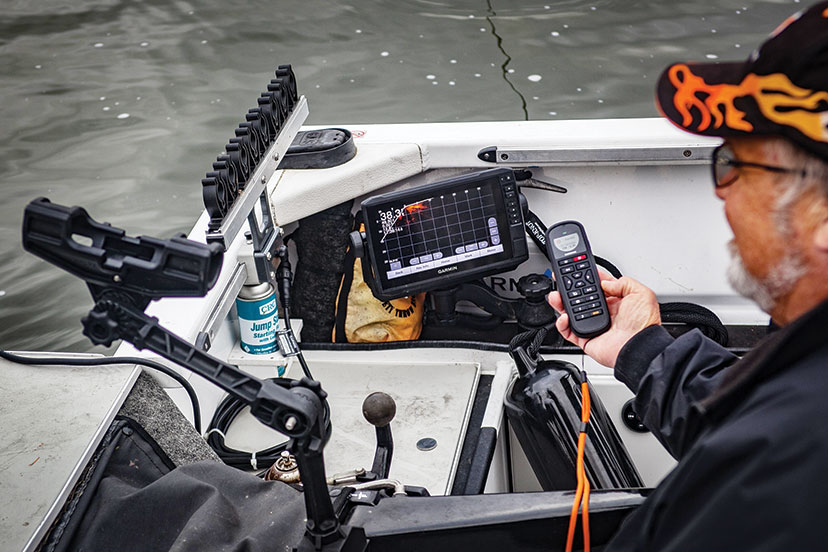
Angler Pete Tracy uses the Garmin Reactor 40 Kicker Remote coupled to the LiveScope-compatible Garmin ECHOMAP UHD chartplotter/sonar and watches his trolling flasher work through the signal cone.
The system is a true plug-and-play and stow-away system, when coupled to the quick disconnect Garmin Panoptix LiveScope extension cable (part number 010-12855-00). Having a removable transducer is a critical feature for my use. Now, I decide if I take the LiveScope mount and transducer, or leave it behind. I also installed downrod storage clips to stow the downrod during travel and when on board but not in use.
To finish up the install Alan suggested a speed wheel (part number SMR11519-001) to help compare on-the-water speed versus over-land speed, which is critical when on the troll.
The total removal and install of all the electronics booked out at just over 20 hours, which translates to dollars if you are hiring it out. An alternate way of thinking about the install is that it saved me time, frustration, and many temper tantrums had I self-installed the system. The installation is squeaky clean, and equally important, the new electronics were ready for their first adventure: a trip up the Snake River Canyon in pursuit of seasonal steelhead and aggressive smallmouth bass.
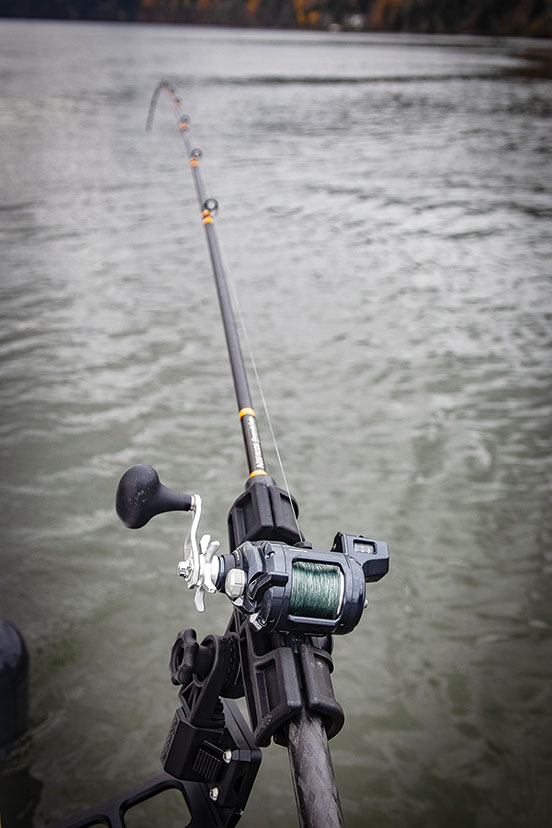
A line-counter reel helps get you in the range, but LiveScope can verify your operating depth.
Trolling is a fundamental technique when fishing from a boat and there are many factors that can make the difference between a nice day cruising the bay and an all-hands-on-deck fishing melee. Now that we’ve made some nice upgrades including the Garmin ECHOMAP ultra-high-definition charplotter/fishfinder, Garmin Reactor 40 Kicker Autopilot, and the Garmin Panoptix LiveScope, let’s see how we can put it all together for a better day on the water. And, since we added the Fusion Bluetooth music system, let’s play a track of Alaskan musician Hobo Jim’s “Wild and Free.”
Trolling might be defined as driving the boat in a forward motion while pulling a bait or lure that is attached to a fishing rod. To add to this definition, we will include the technique of backtrolling, where the boat slips downstream under power while presenting a bait or lure. Sounds simple; how hard can this be?
The art of depth management is probably the single-most-important element when trolling and can be accomplished in a variety of ways. First and foremost, you must know how deep you need to fish, and this can be determined by the depth of the water or by the depth at which the targeted species are located. In both cases a quality fishfinder and chartplotter, like the Garmin ECHOMAP UHD will help determine the depth at which to present lures or baits.
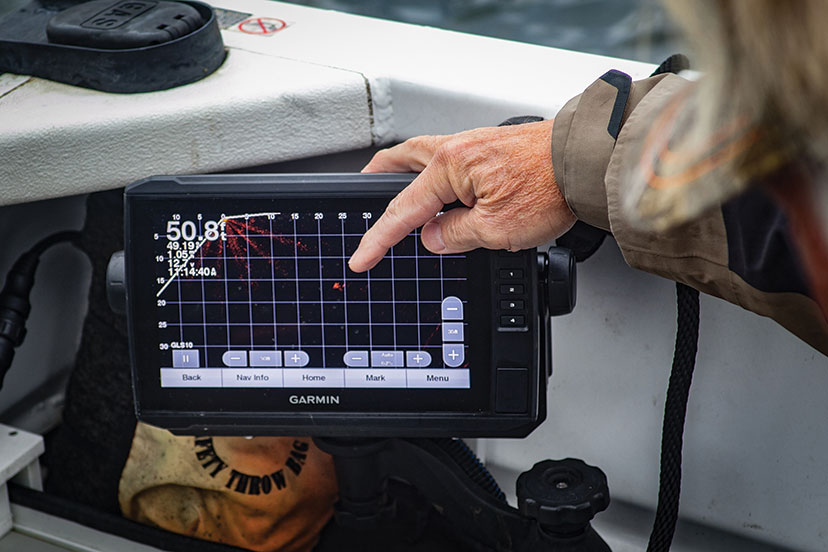
A super-handy benefit of Panoptix LiveScope is knowing the exact depth of your presentation. The flasher is running 24 feet behind the boat at 16 feet deep.
Once you determine the depth of the fish, the effective angler needs to determine the technique utilized to get the presentation into the correct zone. This can be accomplished using downriggers, divers, or sinkers/weights. In some cases, a diving plug can also be trolled without lead or divers.
Downriggers are deadly accurate and effective, but not every boat has downriggers, and in some fisheries downriggers are not warranted or advised. Downriggers come in a variety of types and styles including manual and electronic, and the higher-end downriggers feature preset depth management, depth cycling to cover more water, positive ion control to neutralize negative energy, and bottom tracking, to keep your bait where you want it. Often this means close, but off the river or ocean bottom.
Divers are another popular tool to get your baits down in the water column, but, they lack precise depth management. Delta Divers, Deep Six Divers, Dipsey Divers, Dreamweaver Divers, Jet Divers, and my favorite, the Old Salty Planer are all examples of effective divers. Some of these divers can dive as deep as 200’ or more, but again, it’s hard to be precise, that is, unless you can see your diver on your sonar, and here’s a side benefit of the Panoptix LiveScope, where you can point your transducer at the diver and get a real-time view of the diver’s exact depth.
Sinkers come in a host of sizes and styles. Lead has been the standard, but some of the new-age sinker material is more environmentally friendly, such as dense plastic, brass, steel, tungsten and tin, and even dense concrete marketed under the name MagnaDense.
For the trolling angler, usually a cannonball or keel-type sinker fits the bill. There’s no rule for which style to use, but typically the cannonball style is attached to a dropper where the keel weights are tied inline. Most river anglers will opt for the cannonball, and most salty dawgs will lean towards the inline-keel sinker.
Utilizing a cannonball sinker allows the angler to select a dropper length that corresponds with how far off the river’s bottom the angler wishes to fish their gear. Using a two-foot dropper, the angler can drop the trolled presentation and once the lead starts tapping bottom you simply crank up a turn, and you have your depth set. Cannonball sinkers do not easily snag, and many anglers choose to literally drag their sinkers to guarantee their bait is very close to the bottom and in the strike zone. You can also easily fish the water column when fishing with cannonballs and droppers.
The keel-style, in-line sinker is a great saltwater option because it works well to get the presentation into the strike zone, and it is also very effective when mooching. Typically, a 6- to 12-ounce keel weight works well in the salt, and the faster you troll the shallower the presentation will run. Imagine trolling at a coho-fast pace with your line angle out at 30 degrees. If you have 100 feet of line out, determined by pulls, line counter, or line markings, your estimated depth will be 50% of the line length…or about 50 feet deep. Now, troll a little slower, like when fishing for kings, and your line angle changes to 40 degrees. Your depth changes to 70% or about 70 feet in depth. Again, your depth can be confirmed with that handy LiveScope pointing at the lure.
Plotting a course is an essential strategy when trolling, especially when you are not forced to follow the fleet. Current, wind, tide, and underwater features all influence your plan of action. Good electronics including a quality sonar and accurate cartography help form the strategies and tactics.
Technologies like CHIRP provide amazingly clear, high-resolution images. The Garmin CHIRP ClearVü provides more detailed representation of objects, structure and fish. The Garmin SideVü technology produces highly detailed high-resolution images of structure and fish off either side of the boat.
Utilizing the Garmin Reactor 40 Kicker, the captain can plot a heading-hold trajectory, set up a zig-zag, cloverleaf, or circling pattern, or program in a series of waypoints to chart a path and follow it exactly where you want to go. And best of all, these hands-free features reduce stress and fatigue, allows the captain to oversee other onboard activities, and allows the captain to grab a sandwich while waiting for the fish to grab the presentation. But wait, there’s more…With the Garmin Quickdraw Contours feature, the map detail will improve as the day and the season unfolds.
It’s no secret, if there are no fish around there will not be a lot of catching. But sometimes there are fish around, they just need to be found, and this is where the Garmin Panoptix LiveScope really shines. Imagine trolling through the incoming tide. Fish are entering the system, and it’s your job to troll your presentations in front of your targeted prey. The game just changed with the Garmin Panoptix LiveScope. Simply point your transducer forward. You can even scan left and right. When you see your target, just point and shoot your Garmin Reactor remote, and the boat will proceed in that direction. If your depth is right and your presentation good, your chances are now much better than if you had driven by those fish out of range. In other words, get ready to grab your net.
Now, as we make our troll back to the dock fully satisfied with our new electronics package let’s fire up the Fusion Music System and play Hobo Jim’s “The Fisherman’s Song” in memory of Hobo Jim Varsos—Alaska’s Official Balladeer, 1952 – October 5, 2021.
For more information on the Garmin Reactor 40 Kicker refer to Fish Alaska magazine’s December 2019 Boats column titled “All I want for Christmas is a Garmin Reactor.” Apparently, Santa had supply-chain issues in 2019, but came through early in 2021!
